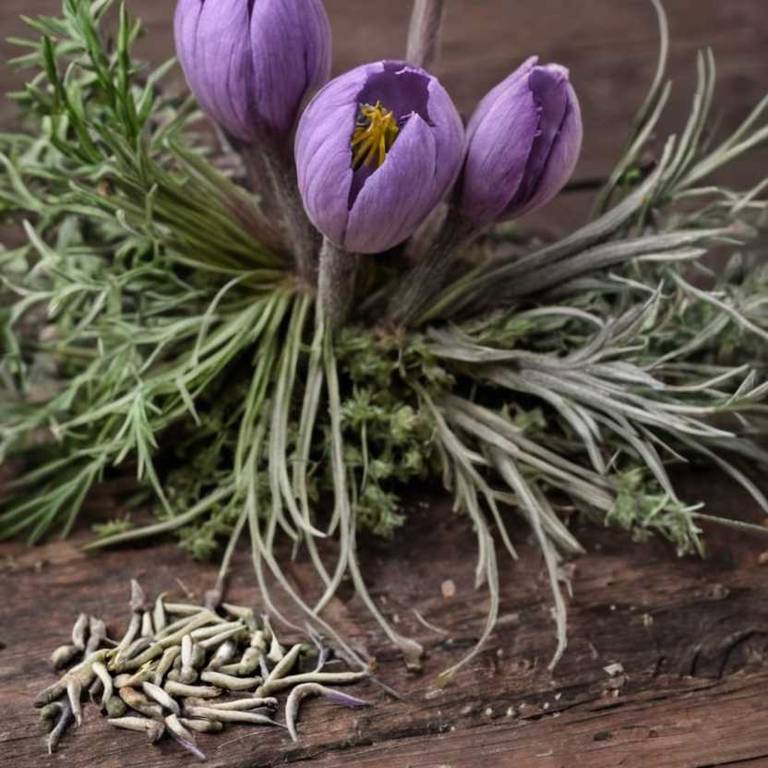10 Best Pulsatilla Chinensis Health Benefits

Pulsatilla chinensis, also known as the Chinese pasqueflower, has been traditionally used in Chinese medicine for its various health benefits.
It is believed to support respiratory health by helping to alleviate symptoms of coughs and colds due to its anti-inflammatory properties. The plant contains bioactive compounds such as flavonoids and alkaloids, which may contribute to its therapeutic effects. It is also used to treat skin conditions and may have antimicrobial properties that help in fighting infections.
However, it is important to note that Pulsatilla chinensis can be toxic if not used properly, and it should only be taken under the guidance of a qualified healthcare practitioner.
1. Boosts immune system
Pulsatilla chinensis boosts immune system by containing bioactive compounds that enhance the body's natural defenses.
These compounds, including alkaloids and flavonoids, help stimulate the production of immune cells such as macrophages and lymphocytes. Traditional Chinese medicine has long utilized Pulsatilla chinensis to treat respiratory infections and other immune-related conditions. Modern research supports its role in reducing inflammation and improving overall immune function.
Regular use of Pulsatilla chinensis may help the body better resist infections and maintain optimal health.
2. Reduces inflammation
Pulsatilla chinensis reduces inflammation by containing bioactive compounds such as alkaloids and flavonoids, which have potent anti-inflammatory properties.
These compounds work by inhibiting the production of pro-inflammatory cytokines and reducing oxidative stress in the body. It has been traditionally used in Chinese medicine to treat conditions like arthritis and skin inflammation, where inflammation plays a central role. Modern research supports its efficacy in mitigating inflammatory responses, making it a valuable herbal remedy.
Its ability to modulate the immune system further enhances its role in managing chronic inflammatory disorders.
3. Improves skin health
Pulsatilla chinensis improves skin health by promoting the regeneration of skin cells and enhancing overall skin texture.
Its anti-inflammatory properties help reduce redness and irritation, making it beneficial for individuals with sensitive or acne-prone skin. The herb also contains compounds that may protect the skin from oxidative stress, contributing to a more youthful appearance. Traditionally used in Chinese medicine, Pulsatilla chinensis is valued for its ability to support skin clarity and reduce the appearance of blemishes.
Regular use of products containing this herb can lead to healthier, more radiant skin over time.
4. Aids digestion
Pulsatilla chinensis aids digestion by supporting the healthy function of the gastrointestinal tract.
It contains compounds that may help regulate digestive processes and reduce bloating and discomfort. This herb is traditionally used in Chinese medicine to treat digestive issues such as indigestion and stomach pain. Its mild laxative properties can help alleviate constipation and promote regular bowel movements.
Overall, Pulsatilla chinensis offers a natural way to enhance digestive health and comfort.
5. Supports respiratory health
Pulsatilla chinensis supports respiratory health by helping to alleviate symptoms associated with respiratory conditions such as coughing, congestion, and inflammation.
Its anti-inflammatory and antimicrobial properties may reduce irritation in the airways and promote clearer breathing. This herb is traditionally used in Chinese medicine to address respiratory discomfort, particularly in cases of colds, flu, and bronchitis. The active compounds in Pulsatilla chinensis may help strengthen the immune system, making it more effective in combating respiratory infections.
Overall, it is considered a valuable natural remedy for maintaining and improving respiratory function.
6. Promotes mental clarity
Pulsatilla chinensis promotes mental clarity by supporting cognitive function and reducing mental fatigue.
This herb is believed to enhance focus and concentration, making it beneficial for individuals experiencing mental fog or stress-related cognitive decline. Its traditional use in Chinese medicine suggests that it helps balance the mind and improve overall mental alertness. The active compounds in Pulsatilla chinensis may contribute to its calming effects, which in turn support clearer thinking.
As a result, it is often used as a natural remedy to enhance mental performance and emotional stability.
7. Enhances nerve function
Pulsatilla chinensis enhances nerve function by promoting the repair and regeneration of damaged nerve cells.
Its active compounds, such as alkaloids and flavonoids, support the myelination process, which is essential for efficient nerve signal transmission. This herb is particularly beneficial for conditions involving nerve damage or degeneration, such as neuropathy. The anti-inflammatory properties of Pulsatilla chinensis also contribute to reducing nerve inflammation, further supporting its role in neurological health.
Overall, it serves as a valuable natural remedy for improving nervous system function and overall well-being.
8. Reduces anxiety
Pulsatilla chinensis reduces anxiety by modulating the nervous system and promoting emotional balance.
It contains bioactive compounds that may influence neurotransmitter activity, helping to alleviate symptoms of stress and anxiety. Traditional Chinese medicine has long used this herb to calm the mind and ease psychological distress. Modern research suggests it may support the body's natural stress response mechanisms.
As a result, Pulsatilla chinensis is considered a valuable herbal remedy for managing anxiety naturally.
9. Improves sleep quality
Pulsatilla chinensis improves sleep quality by promoting relaxation and reducing anxiety, which are common contributors to sleep disturbances.
Its sedative properties help calm the nervous system, making it easier for individuals to fall asleep and stay asleep throughout the night. Traditional Chinese medicine has long used this herb to address insomnia and other sleep-related issues, highlighting its historical efficacy. Modern research suggests that the active compounds in Pulsatilla chinensis may influence neurotransmitter activity, further supporting its role in enhancing sleep patterns.
Overall, it offers a natural and holistic approach to improving sleep quality without the side effects often associated with pharmaceutical sleep aids.
10. Supports detoxification
Pulsatilla chinensis supports detoxification by aiding the body in eliminating harmful toxins through its bioactive compounds.
The plant contains various phytochemicals that may enhance liver function, which is crucial for metabolic detoxification processes. It is believed to stimulate the production of enzymes that help break down and expel toxins from the body. This detoxifying effect can contribute to improved overall health and vitality.
Regular use of Pulsatilla chinensis may support the body's natural cleansing mechanisms, promoting better internal balance.